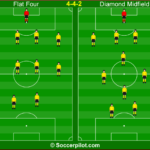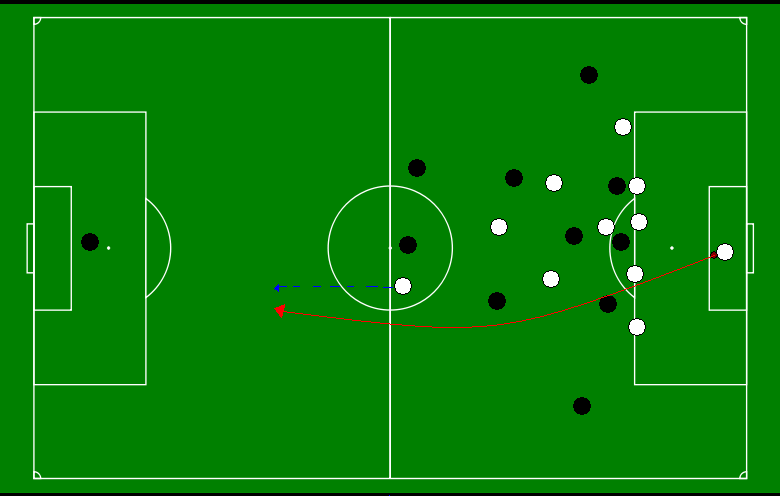 Soccer strategy encompasses a wide variety of concepts, from the formation and tactics the whole team utilizes to individual decisions on positioning and what to do with the ball when you have it.
Soccer strategy encompasses a wide variety of concepts, from the formation and tactics the whole team utilizes to individual decisions on positioning and what to do with the ball when you have it.
One key aspect of strategy on the player level is how often to take risks, which can lead to positive outcomes for the team but also carries the possibility of bad ones.
To be clear, we aren’t talking about risks in terms of the possibility of suffering injuries. This obviously is an important topic but that’s a discussion for another day: in this article we’re thinking of the risk of in-game outcomes like losing the ball or giving up a scoring chance or a goal.
And the potential rewards of a risky move that succeeds are similar: winning the ball, getting it into dangerous areas, and scoring a goal of your own.
With that understood, let’s dig in.
Taking a Risk vs. Playing Simple?
Taking a risk in soccer can be contrasted with playing simple. Simple play includes opting for conservative passes that are high percentage, like lateral or backward passes to teammates.
These are the safest of options for you: the odds that your team keeps possession are high, but at the same time you aren’t getting the ball into more dangerous areas.
Risker passes are the ones that break the lines; that switch the point of attack unexpectedly; that put an opponent through on goal.
Since these passes are closer to your attacking third and are usually in numbers down situations (there are more defenders compared the the number of attackers), they will not succeed a high percentage of the time. But when they do, they can directly lead to high-quality scoring chances.
This is not just about passing: “riskier” plays can be your decision to shoot or dribble a player 1 on 1 instead of playing a simple ball back to a teammate. It can also mean the runs that you make, both individually and as a team.
To give another example, say you win the ball back from the opposition. The safe play will usually be to find a simple pass so your team can keep the ball and not take chances to give it right back; the riskier play may be to immediately launch an attack in hopes of catching your opponent off-guard or out of position.
No matter what, simple play is undoubtedly a fundamental skill in every player’s toolkit. Even if a single pass doesn’t break down the opposition, possession is such a key factor in soccer that in most cases, you want to opt for safety over risk so that your team can keep and recycle possession and be ready to strike when an opening or vulnerability presents itself.
The problem, then, comes when you only look to simple and safe plays and never look to take risks. This can be associated with a belief that players should strive to never make mistakes.
Youth coach Mike Singleton wrote about the need to take risks in an article on Soccer America:
It was amazing how rarely such talented and skilled players were willing to take risks on the field and try something new. Most players seemed to believe that if they did not make a mistake, they would make the regional or national team … Only through risking making mistakes and daring to try new things will (players) find ways to raise their game. Not giving the ball away is not in itself a quality that makes a player “great.” Our country needs players who can change the game positively and dynamically. We need players who can see and make dangerous penetrating passes. We need players who have the courage and skill to take on the last two defenders and slip the ball past the keeper. We need defenders who are skilled enough and willing to join the attack … Only by encouraging these players to take risks and to try their own ideas, will these players have a chance to be better.
When (and Where on the Field) Is Taking a Risk Worth It?
By this point we now understand that simple play forms a solid base that every player needs, but that risk taking at the right times is necessary to reach your full potential as a player. So what, then, are the right times?
There are a few factors to consider. One is your location on the field. In your defensive third, the risk-to-reward calculation rarely justifies taking a significant risk. If the risky move pays off, you still have much of the field ahead of you, and losing possession can be devastating due to your proximity to your own goal.
In contrast, your attacking third is the best place to take risks for the same token. The midfield, then, is a more gray area where you want to evaluate other aspects of the situation in order to decide whether to take a risk or not: how much cover do you have if the ball gets intercepted? Is this move likely to get me or my teammate in on goal if it succeeds?
Of course, when you’re playing you don’t have the time to take the luxury of stopping to think about your options; instead, the more experience you get the larger your mental toolkit of on-field situations becomes, which helps you understand how risks and rewards tend to play out. A good coach will also design training activities that help you learn how to take risks in a more controlled environment. (We found a few here from coach Wesley Syed on the website Sport Session Planner.)
It’s also important to consider the overall situation of the game. If your team is trailing by a goal, for example, and it’s late in the game, it might be time to take a bigger risk that you normally wouldn’t.
In addition to the “risky” plays we’ve discussed, this could be making an ambitious late run into the box in hopes of getting on the end of a cross or a rebound when normally you would hang back to be in position to defend.
Sometimes you even see a team send their goalkeeper into the opposition’s box for a corner kick or other dead ball when it’s likely to be their last chance to score. And what could possibly be riskier than that?






Leave a Reply